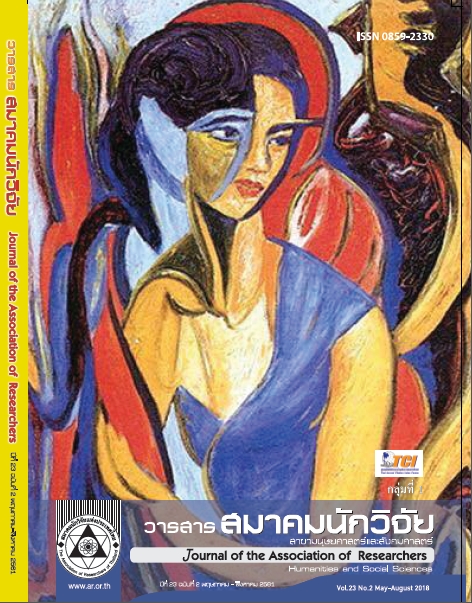The Applications by the Cultural Community of Amphoe Sam Khok, Pathum Thani Province in the Crime Control
Main Article Content
Abstract
The apply of community culture lifestyle of peoples in Amphoe Samkhok, Pathum Thani Province towards crime control were origin from the researcher’s interesting to study about the apply their community culture lifestyle to be mechanism to control crime in this area, especially using of Social values, and beliefs in the community to be the main instruments. Following to the study about Mon descendance peoples resides in Amphoe Samkhok by the researcher, it reveals that the group of their ancestor were moved to reside in this area since the Ayuthaya era. Most of the Mon descendance peoples respects to the Bhudism, including the believe as “Pee” (ghost) is liken be the sacred that always protecting to all of the peoples in community. Furthermore, in each family believed that eldest son is regards to the important person, because of his responsible to keep that private property of the ghost. With this belief, eldest son of Mon descendance peoples should be stricted in traditions and to be good behavior man. Then, the belief becomes good effect for crime control, implicitely. Other traditions such as: funeral ceremony; Sonkran; the end of Buddhist lent and give food offering to hundred Buddhist monk on boat; including to the rice porridge stirring tradition that always made of unity in the Mon descendance peoples in the community. Tradition towards respect to elder peoples, and to follows that other old and fine tradition and culture is the important mechanism of the community for participation of children and youth group, including to be good mechanism of crime protect and control. Because of the community culture lifestyle of Mon descendance peoples in Amphoe Samkhok is the effective social mechanism for crime control. Thus, it becames to be role model for other communities for applying of community culture lifestyle likes traditions; cultures; and beliefs to be instrument for crime control. The results as above-mentioned were indicated that co-operation amongs each of public sector, making knowledge about important of community culture lifestyle for all over people, and to understanding and accept to community culture lifestyle by legal officers and government sectors is the most important, especially in the applying of community culture lifestyle to be mechanism of crime control.
Article Details
บทความที่ปรากฏในวารสารนี้ เป็นความรับผิดชอบของผู้เขียน ซึ่งสมาคมนักวิจัยไม่จำเป็นต้องเห็นด้วยเสมอไป การนำเสนอผลงานวิจัยและบทความในวารสารนี้ไปเผยแพร่สามารถกระทำได้ โดยระบุแหล่งอ้างอิงจาก "วารสารสมาคมนักวิจัย"
References
กิ่งแก้ว มรกฎจินดา. (2550). การศึกษาวัฒนธรรมไทยโช่งเพื่อการจัดการเรียนรู้: กรณีศึกษา ณ หมู่บ้านสะแกราย ตำบล ดอนยายหอม อำเภอเมืองและหมู่บ้านลำเอียด ตำบลตลาดอินคา อำเภอสามพราน จังหวัดนครปฐม. นครปฐม: มหาวิทยาลัยศิลปากร.
ธีรพงษ์ แก้วหาวงษ์. (2544). กระบวนการเสริมสร้างชุมชนเข้มแข็งประชาคม: ประชาคม ประชาสังคม. กรุงเทพฯ: โรงพิมพ์คลังนานา.
นวลจันทร์ ทัศนชัยกุล. (2556). ระบบงานยุติธรรม: ยุคใหม่. จันทบุรี: โรงพิมพ์พรทิพย์การพิมพ์. ประเวศ วศี. (2539). การพัฒนามนุษย์ตามแนวทางมนุษย์นิยม. กรุงเทพฯ: มูลนิธิหมอชาวบ้าน.
ปุระชัย เปี่ยมสมบรูณ์. (2526). การควบคุมอาชญากรรมจากสภาพแวดล้อม: หลักทฤษฎีและมาตรการ. กรุงเทพฯ: โอเดี่ยนสโตร์.
ประธาน วัฒนวานิช. (2520). ระบบความยุติธรรมทางอาญา: แนวความคิด เกี่ยวกับการควบคุมอาชญากรรมและ กระบวนการนิติธรรม. วารสารนิติศาสตร์ มหาวิทยาลัยธรรมศาสตร์, 9(2), 150.
ผ่องพรรณ มณีรัตน์. (2521). การเปลี่ยนแปลงทางสังคมและวัฒนธรรม. กรุงเทพฯ: มหาวิทยาลัยธรรมศาสตร์. สุรเชษฎ์ เวชพิทักษ์. (2533). รากฐานแห่งชีวิต: วัฒนธรรมชนบทกับการพัฒนา. กรุงเทพฯ: หมู่บ้าน.
สุภรณ์ โอเจริญ. (2541). มอญในเมืองไทย. กรุงเทพฯ: โรงพิมพ์มหาวิทยาลัยธรรมศาสตร์.
สำนักงานสถิติแห่งชาติ. (2558). คดีอาญาที่สำคัญ. สืบค้นเมื่อวันทที่ 29 ตุลาคม, 2560, จากเวปไซต์: http://service.nso. go.th/nso/web/statseries/statseries13.html.
อานนท์ อาภาภิรม. (2515). มนุษย์กับสังคม: สังคมและวัฒนธรรมไทย. กรุงเทพฯ: โรงพิมพ์บำรุงนุกูลกิจ.
อนุชาติ พวงสำลีและกฤตยา อาชวนิจกุลคณะ. (2542). ขบวนการประชาสังคมไทย: ความเคลื่อนไหวภาคพลเมือง. กรุงเทพฯ: โรงพิมพ์ อมรินทร์พริ้นติ้ง.
Johnson, G. B. (1978). The Living World. Massachusetts: McGraw-Hill. Kawehawong, Teerapong. Community Empowerment Process: Civil Society. Bangkok: klungnana. (in Thai).
Maneerat, Pongpan. (1978). Social and Cultural Change. Bangkok: Kasetsart University. (in Thai).
Morakotjinda, Kingkaew. (2007). A study Thai Song culture for knowledge management a case study of Sakarai Village Donyaihaum Subdistrict Mueang District and Rumieag Village Talard Jinda Subdistrict Samphan District Nakhon Pathom Province. Nakhon Pathom: Silpakorn University. (in Thai).
National Statistical Office. (2015). Criminal Case is Important. Retrieved October, 29, 2017, from: http:// service.nso.go.th/nso/web/statseries/statseries13.html. (in Thai).
Ocharoen, Suporn. (1998). The Mons in Thailand. Bangkok: Thammasat Printing House. (in Thai).
Friday Paul C., Harry E. Allen, Julian B. Roebuck and Edward Sagarin. (1978). Crime and Punishment: An Introduction to Criminology. New York: Free Press.
Pathumthani Provincial Police. (2016). Crime Statistics in Pathumthani Province. Pathumthani: Pathumthani Provincial Police. Piumsomboon, Piumsomboon. (1983).
Crime Control through Environmental Design. Bangkok: Odeonstore. (in Thai).
Tadsanachaikul, Nuanchan. Justice System: New Age. Chanthaburi: PhonThip Printing. (in Thai).
Vejpitak, Vejpitak. (2010). Foundation of Life: Rural Culture and Development. Bangkok: Village. (in Thai).
Wasi, Prawet. (1996). Human Development by Humanism. Bangkok: Folk Doctor Foundation. (in Thai).
Wattanawanit, Prathan. (1977). Criminal Justice System: Concept of Crime Control and the Rule of Law. Thammasat Law Journal, Thammasart University 9(2), 150. (in Thai).


